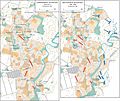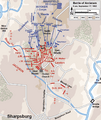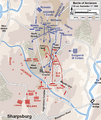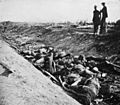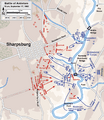Battle of Antietam facts for kids
Quick facts for kids Battle of Antietam |
|||||||
|---|---|---|---|---|---|---|---|
| Part of the American Civil War | |||||||
 Battle of Antietam by Kurz and Allison. |
|||||||
|
|||||||
| Belligerents | |||||||
| United States (Union) | CSA (Confederacy) | ||||||
| Commanders and leaders | |||||||
| George B. McClellan | Robert E. Lee | ||||||
| Strength | |||||||
| 87,000 | 45,000 | ||||||
| Casualties and losses | |||||||
| 12,401 (2,108 killed, 9,540 wounded, 753 captured/missing) | 10,316 (1,546 killed, 7,752 wounded, 1,018 captured/missing) | ||||||
The Battle of Antietam was a very important battle during the American Civil War. People in the South sometimes call it the Battle of Sharpsburg. This huge fight happened on September 17, 1862, near Sharpsburg, Maryland. It was known as the bloodiest single day of the entire Civil War.
It was also the first major battle of the Civil War to take place in the border states. Both sides hoped a big win would end the war quickly. About 22,720 soldiers were killed, wounded, or went missing at Antietam. No other single-day battle in American history has had so many casualties. However, some battles that lasted longer, like the Battle of Gettysburg, had even more casualties over several days.
Contents
Why the Battle Happened
During the summer of 1862, the North's hope for a quick end to the rebellion was fading. In July, Major General George B. McClellan's plan to capture the Southern capital at Richmond, Virginia failed. Then, in August, the Second Battle of Bull Run was another win for the Confederates.
The Union armies had to retreat back to Washington, D.C., which was only a few miles away. In other states like Tennessee, Confederate attacks were also working. This made the Union army feel very discouraged.
After winning at Bull Run, General Robert E. Lee led his Confederate Army of Northern Virginia into Maryland. This started his Maryland Campaign. Lee had several reasons for attacking the North. First, it was harvest time in the Shenandoah Valley. Lee needed to make the Union army look away from his army's food sources.
Second, he hoped to get help from countries in Europe. A big win in the North could bring the support they needed. It might also cause the border state of Maryland to leave the Union. Lee also thought the Union army needed time to get ready again. He believed if he moved fast, he could surprise them.
Getting Ready for Battle
| Opposing army commanders |
|---|
|
In a very brave move, Lee split his Army of Northern Virginia into five smaller groups. He sent three groups with General "Stonewall" Jackson to attack and hold Harpers Ferry. This would give Jackson control of the Shenandoah Valley. Lee sent his largest group, led by Lieutenant General James Longstreet, towards Sharpsburg, Maryland.
Lee wrote down all his plans in a paper called Special Order 191 on September 9. By a strange twist of fate, a copy of this order was wrapped around some cigars and dropped in a field. Union soldiers found it and sent it to General McClellan.
McClellan was still in charge of the Army of the Potomac, even though he had not helped at the Second Battle of Bull Run. When Lee entered Maryland, McClellan moved faster than usual to stop him. Knowing Lee's plans gave McClellan a chance to defeat Lee's army while it was split up.
McClellan learned of Lee's plan on September 13. He proudly said, "Here is a paper with which if I cannot whip Bobbie Lee, I will be willing to go home." He also sent a telegram to President Lincoln, saying, "I have all the plans of the rebels, and will catch them in their own trap." But McClellan waited another 18 hours before acting. This delay gave Lee more time to bring his army back together.
As Lee moved into Maryland, he left small groups of soldiers to guard two mountain passes. These were the most important routes through the 50-mile long South Mountain. If McClellan had moved faster, he could have caught Lee's army scattered on the other side. The Union army caught up with Lee at Frederick, Maryland, and fighting began on South Mountain. This was a natural mountain range that separated the valleys from eastern Maryland. Several battles were fought that day for control of South Mountain. The Confederates were pushed back with many casualties. McClellan could have destroyed Lee's army, but he waited again, giving Lee time to regroup.
The Main Battle Day
Three days later, on September 17, 1862, the two armies met again. This time, they fought between Antietam Creek and Sharpsburg, Maryland. The Battle of Antietam was not just the bloodiest day of the American Civil War. It was the single bloodiest day in all of American history. The Confederate troops took strong positions behind Antietam Creek. McClellan then decided to attack.
The battle happened in three main parts throughout the day.
Morning Attacks
At dawn on September 17, Union soldiers led by Major General Joseph Hooker attacked Lee's troops from their left side. As the two armies fought, the battle spread across a local cornfield. It also raged around the Dunker Church.
Midday Fighting
The Union troops kept attacking the Confederates at a place called the Sunken Road. They managed to break through the middle of the Confederate lines. This was when the most brutal and deadly part of the battle took place.
Afternoon Push
Late that afternoon, more Union soldiers joined the fight. These troops were led by Major General Ambrose Burnside. They captured a stone bridge over Antietam Creek. Then, they moved towards the Confederate troops' right side.
But as Burnside's soldiers attacked, more Confederate soldiers arrived. Confederate Major General A.P. Hill had led his division of soldiers all the way from Harpers Ferry to Antietam. When Hill's division arrived, they were able to counterattack. This means they fought back against Burnside's soldiers.
This surprise attack worked very well. The Confederate troops pushed Burnside's soldiers back. This ended the battle. Even though he had more soldiers, McClellan could not destroy Lee's army. Lee was able to move his troops around to meet each of McClellan's attacks. McClellan also did not use his many reserve forces (soldiers on standby). These reserves could have helped the Union win even more.
What Happened After
The next day, both armies gathered their wounded soldiers and buried their dead. Then, Lee pulled back his army to Virginia. McClellan did not chase after Lee, which made President Lincoln very upset.
From a military point of view, the battle was a draw. But because Lee's forces left Maryland, Lincoln said it was a victory for the Union.
Interesting Facts about Antietam
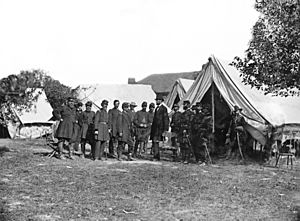
- Even though the Battle of Antietam was called a Union victory because Robert E. Lee retreated, the battle itself was a tie.
- The battle was much deadlier because of new guns. These guns allowed soldiers to shoot more accurately and from farther away.
- Six generals died or were badly wounded in the battle.
- Future President William McKinley was a Sergeant and fought in the Battle of Antietam for the Union.
- Abraham Lincoln used this battle as a chance to announce the Emancipation Proclamation on September 22, 1862. This document, starting January 1, 1863, declared all enslaved people in the Confederate states to be free.
- Abraham Lincoln thought McClellan was not a good leader. He believed McClellan should have defeated the Confederate army completely. So, on November 7, Lincoln removed McClellan from command of the Army of the Potomac. After leaving the army, McClellan went into politics and ran against Lincoln in the 1864 election.
Images for kids
-
Photograph by Alexander Gardner of Lincoln and McClellan near the Antietam battlefield, October 3, 1862
-
Maj. Gen. George B. McClellan, Army of the Potomac (USA)
-
Gen. Robert E. Lee, Army of Northern Virginia (CSA)
-
Harper's Weekly drawing of dead soldiers on Antietam battlefield, based on Gardner photograph
See also
 In Spanish: Batalla de Antietam para niños
In Spanish: Batalla de Antietam para niños






